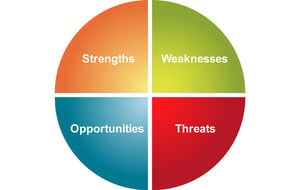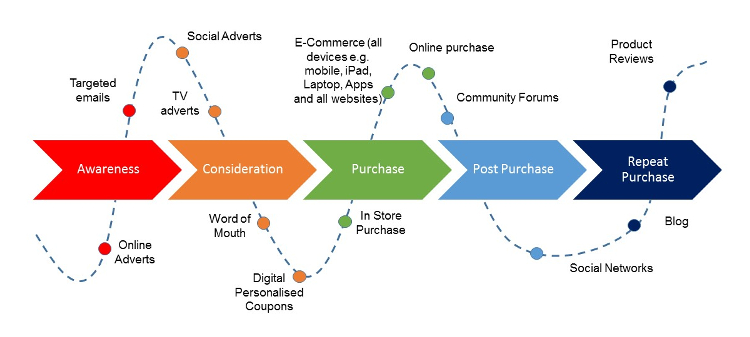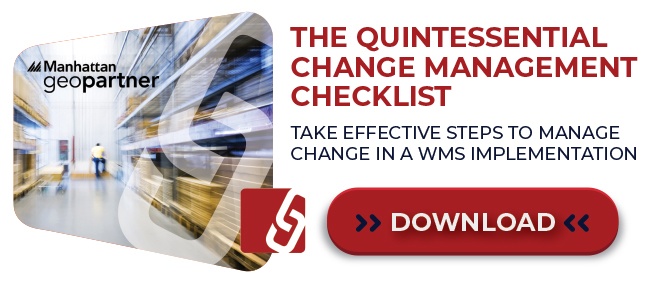A WMS implementation guide to managing organisational change


Whatever your industry, you know that a process overhaul is likely to create change throughout your organisation, whether you’ve anticipated it or not. Since we know our systems and understand the far-reaching impact of updating your warehouse management systems, we’re taking the guesswork out of it.
From start to finish, here is the ten-step guide for managing this organisational change to successfully implement a WMS in your business:
Step 1 - Identify the need: why change your systems?
In the current sales climate, all industries are feeling the push to upgrade their WMS and processes to ensure a cleaner and quicker delivery of product to client.

Knowing your motivation and goals clear during the process will ensure that your Warehouse Management System is implemented in a way that delivers on your objectives.
What do you ultimately want to achieve? You can establish this with a simple SWOT analysis on your industry vs your organisation.
Not convinced that you need WMS? See when you may need a WMS here, or find out more about how outdated ERP's affect your business here.
Step 2 - Get specific by identifying your needs and parameters
Planning ahead is key to achieving the outcomes you need from your WMS. Do you have the correct processes, structures and teams in place?
For your business:
- An honest needs-analysis which gives you an unobstructed view of your requirements.
For your industry:
- A solid assessment of your environment, your competition, and your ability to accomplish your goals in a reasonable timeframe.
For your workforce:
- A change management team with a strategy to sell the changes in systems, processes, and culture to the workforce, getting employee buy-in early on.
Step 3 - Kick-starting change for improved understanding.
Implementing a system that will disrupt your business can end up disrupting your workforce, too.
To make sure the disruption is positive, you should know the difference between CHANGE MANAGEMENT and TRAINING.
Encouraging collaboration and company-wide interaction during the planning, approvals, implementation, and review stages will smooth the final training process.
Step 4 - Understand the impact on departments, and plan ahead.
Which departments within your organisation are going to be affected by the new Warehouse Management System?
This question is a simple one which becomes incredibly complex once you take the knock-on effects of the new system into account. Ensure you start off with the big picture in mind.
- Understand the capabilities of your potential WMS
- Establish the impact per department
- Assess the scope-specific changes vs out-of-scope changes
- Plan for the transition
Remember: all the affected departments must understand and accept the changes to their everyday operations. Ensure that they are ready for training and implementation by following step 3.
Step 5 - Implementing with deep analysis and system design.
Changes to the original project scope will come out in the wash. During the implementation process, you have the opportunity to do a deeper analysis of your business needs and goals and amend the system design to accommodate your new requirements.
- Take the opportunity to examine and update your original specifications
- Analyse and optimise your business processes
- Understand the common organisational changes and account for unexpected ones.
Because these elements may shift the goalposts, you’ll need to be hyper-aware of any new hurdles or challenges you’ve uncovered in the process.
Step 6 - Adaptation: teething issues within your business.
Just like the path to success, the change management process is not perfectly linear. Accommodating and anticipating the challenges that your workforce will encounter with the new WMS is key to helping them adapt.
Consider all of your involved departments and their goals in your change management strategy:
- Warehouse
- Sales
- Operations
- Finance
- Marketing
Step 7 - The culture clash: how to mitigate change-resistance.
While many businesses don’t account for it, a new process, system, or procedure will drive significant culture changes within the company. Being aware of these changes and the responses they elicit is critical:
- Challenges and roadblocks
- Resistance by employees
- Efficiency and productivity changes within the workforce
- New interactions and unexpected impacts on your supply-chain
- Positive vs. negative disruption
Step 8 - Keep your customers by preventing errors during roll-out.
Your goal is to deliver your products and services quicker, in a simpler way, with fewer hitches. Keep this in mind when you notify your customers of your new systems, processes, or requirements that impact their journey.
- Ensure that you eliminate any misunderstandings or miscommunications
- Ensure that your customer’s goals are achieved throughout the process.
- Keep your service level at 100%

This is where your full organisation must be working at its optimum: Every touch point that a customer encounters needs to drive your new operating processes and ensure that no customer is left behind.
Step 9 - Going for a seamless, controlled integration.
Let’s get technical: The integrations available to you on your WMS will vary, and the impact it will have on your business is different for every organisation. Ensure that you a full understanding of the integrations required:
In-scope integrations
The obvious integrations that are give to you in the project scope, which you may either need to implement or update to sync with your WMS.
Out-of-scope integrations
Unexpected integrations that may demand a last-minute update, upgrade, install or implementation.
Find out more about integration, timelines, and what to expect from a WMS implementation: HOW LONG DOES IT TAKE TO IMPLEMENT A WMS?
Step 10 - Anticipate and plan the full cost-to-company.
As you may now see, the unpredictable elements within the implementation process may cause you to grossly underestimate the project’s cost to company. Before you approve the initial project scope, ensure that you know what could come out of the woodwork, specific to your business:
- Common planning errors
- Common scope changes and updates
- The cost implications of the above on similar business projects
You may need to adjust your ROI projections or find a way to account for these extra costs so that you reduce your surprises and keep the costs under control.
See the full change management breakdown in our Quintessential Change Management for WMS Implementation Checklist:
TAGS
- WMS (51)
- Warehouse Best Practice (46)
- Implementing a WMS (29)
- Managing your warehouse (19)
- Omni Channel (18)
- eCommerce (18)
- Blog (16)
- Supply Chain Best Practice (16)
- Customer Journey (9)
- Mid-Level (8)
- Warehouse optimisation (7)
- General Tips (5)
- Industry General (5)
- Information (5)
- Trends (5)
- managing your Supply Chain (5)
- saudi arabia (5)
- Press Release (4)
- smart warehouse (4)
- 3PL (3)
- News (3)
- ERP (2)
- Entry-level (2)
- ROI (2)
- Case Study (1)
- OMS (1)
- Picking (1)
- Solution-Specific (1)
- Transport Management System (1)
Take A Look At The Results Of A Successful WMS Implementation.
See how Tarsus Distribution, in collaboration with SCJ boost overall efficiency by 60%




